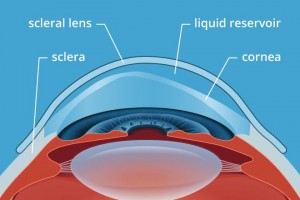Scleral contacts are large-diameter gas permeable contact lenses specially designed to vault over the entire corneal surface and rest on the sclera, or the “white” of the eye. In doing so, scleral lenses functionally replace the irregular cornea with a perfectly smooth optical surface to correct vision problems caused by keratoconus and other corneal irregularities.
Also, the space between the cornea and the back surface of a scleral lens acts as a fluid reservoir to provide comfort for people with severe dry eyes who otherwise could not tolerate contact lens wear.

Scleral Contact Lenses For Keratoconus
Many optometrists recommend scleral contact lenses for a variety of hard-to-fit eyes, including eyes with keratoconus.
In cases of early keratoconus, a standard GP lens may be used. However, if the lens does not center properly on the eye or moves excessively with blinks and causes discomfort, switching to a large-diameter scleral contact lens may solve the problem.
Because scleral lenses are designed to vault the corneal surface and rest on the less sensitive surface of the sclera, these lenses often are more comfortable for a person with keratoconus.
Also, scleral lenses are designed to fit with little or no lens movement during blinks, making them more stable on the eye, compared with traditional corneal gas permeable lenses.
Scleral Lenses for Severe Dry Eye
The best approach to managing dry eye is based upon its etiology and severity. Dry eye syndrome can be difficult to manage in severe cases. In patients who are unsuccessful with traditional treatment, alternative treatments may be considered for dry eye syndrome, including scleral lenses. When selecting a contact lens for severe dry eye, not all lenses are appropriate. On the contrary, some can do more harm than good. However, scleral lenses specifically have been shown to have beneficial effects on patient comfort and visual function.
Scleral lenses are a relatively new type of treatment for ocular dryness. A scleral lens is a large-diameter contact lens that vaults across the entire corneal surface and rests on the white part of the eye, known as the sclera. Liquid fills the space between your eye and the back surface of the scleral lens. This liquid bandage protects the cornea from the ongoing mechanical shearing effect of the eyelids that occurs when you blink. It also continuously bathes your sensitive corneal tissue.
If you have dry eye and also require vision correction, the scleral lens is additionally helpful because other contact lens options may be limited by the compromised state of your ocular surface. As a result, you will most likely be unable to tolerate conventional soft lenses or small diameter corneal gas permeable lenses. Fortunately, scleral lens designs can overcome the challenges associated with the other contact lens types – these lenses work especially well for vision correction because the fluid layer helps smooth out defects caused by dry eyes, providing a more uniform refractive surface.
Scleral Contact Lenses For Other Eye Problems
In addition to keratoconus, scleral contact lenses can be used for eyes that have undergone a corneal transplant, and for people with severe dry eyes caused by conditions such as Sjogren’s syndrome, graft-versus-host disease (GVHD) and Stevens-Johnson syndrome.
Advances in lens design technology are allowing manufacturers to design scleral lenses that can correct more conditions than ever before, including bifocal sclerals for the correction of presbyopia.
Scleral contact lenses are custom-made for each wearer, so fitting scleral contacts demands greater expertise and more time than fitting standard soft or GP contact lenses.
Often, computerized maps of the curvature of the entire cornea (topography) are generated to facilitate the lens fitting, and several trial lenses of different sizes and curvatures may be applied to the eye during the fitting process.
Also, depending on the complexity of the problem and how the individual eye tolerates the scleral lens, adjustments of lens parameters may be needed, which will require additional lenses to be made and exchanged. The entire scleral lens fitting process can take several visits to determine the optimal lens for each eye.
While many individuals who use scleral lenses have worn soft or corneal GP lenses in the past, the process for applying and removing scleral lenses may take some practice. The additional time needed to master this, due to the larger size of the lenses and the fluid reservoir under the lenses, needs to be taken into consideration during the fitting process.
Scleral Lens Cost
In some cases, depending on your diagnosis, your vision plan will cover a potentially large portion of the cost for the lens fitting and the lens materials. Patients with corneal abnormalities or large prescriptions (+/- 10.00 D in spectacle Rx) may qualify for “medically necessary contact lens benefits”. You can contact our office to have us look into the details of any vision plan you have.

